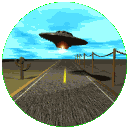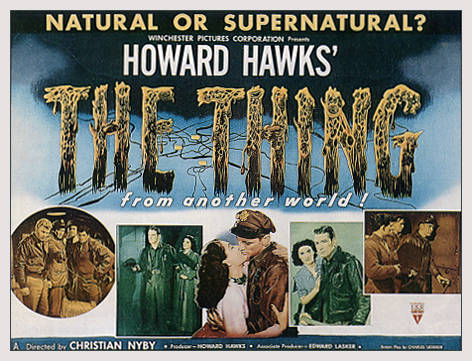See if your favorite person, TV series or motion picture is available: video/DVD/books


 Intro by Lang Thompson & Jeff Stafford
Intro by Lang Thompson & Jeff StaffordDespite its laugh-inducing title, The Thing from Another World (1951) turned out to be such a taut, well-made film that even people not enamored of science fiction admit that it's a classic. At the time of the film's release the New York Times wrote: "Not since Dr. Frankenstein wrought his mechanical monster has the screen had such a good time dabbling in scientific fiction....the film is full of unexpected thrills" and audiences were in total agreement. Contemporary film writers Bill Warren (Keep Watching the Skies) and Tom Weaver (Universal Horrors) both consider it one of the ten best science fiction films ever, and they're hardly alone in their assessment.  The film begins as Air Force Captain Hendry (Kenneth Tobey) and his crew head to the Arctic to investigate reports of a mysterious aircraft that crashed there. Upon arrival, he discovers a scientific expedition already encamped there and close to locating the crash site. Hendry also encounters his former girlfriend, Nikki (Margaret Sheridan), who is working for the scientists as a secretary. Soon the group uncovers the alien aircraft buried in the ice and once they melt through to the wreckage, the situation quickly escalates from unpredictable to terrifying.
The film begins as Air Force Captain Hendry (Kenneth Tobey) and his crew head to the Arctic to investigate reports of a mysterious aircraft that crashed there. Upon arrival, he discovers a scientific expedition already encamped there and close to locating the crash site. Hendry also encounters his former girlfriend, Nikki (Margaret Sheridan), who is working for the scientists as a secretary. Soon the group uncovers the alien aircraft buried in the ice and once they melt through to the wreckage, the situation quickly escalates from unpredictable to terrifying.Undoubtedly the most famous controversy over The Thing is whether Howard Hawks - listed here as a producer - actually directed most of the film instead of the credited director, Christian Nyby. In an interview with Peter Bogdanovich for his book, Who the Devil Made It? (Ballantine Books), Hawks commented on the mystery: "Chris Nyby had done an awfully good job as the cutter on Red River and he'd been a big help to us too, so I let him do it. He wanted to be a director and I had a deal with RKO that allowed me to do that. I was at rehearsals and helped them with the overlapping dialogue - but I thought Chris did a good job." Nevertheless, a few people on the set later claimed that Hawks did much of the daily directing and there are even photos that tend to support this. It's also clear that The Thing shares strong similarities with other Hawks films that deal with group dynamics, particularly in situations where everyone, women included, are working under pressure and are being judged by their performance. Take a look at any Howard Hawks movie, from Only Angels Have Wings (1939) to Air Force (1943) to Hatari! (1962), and it's remarkable how many of his films fit this pattern, including The Thing. As for credited director Christian Nyby, who had previously won an Oscar for his editing of Red River (1948), it would be another six years before he would helm another picture - Hell on Devil's Island (1957). But enough about the true director of The Thing. The film was based on a story by John W. Campbell, Jr., who was one of the key figures in the development of science fiction: he worked as the editor of Astounding (which later became Analog) for almost four decades and helped launch the careers of Robert Heinlein, Arthur C. Clarke, Isaac Asimov, and numerous other writers. Interestingly, Campbell's own story "Who Goes There?," first published in 1938 under the pseudonym Don Stuart, was decidedly more paranoid than the 1951 film version of The Thing. For the screenplay, scenarist Charles Lederer actually discarded most of the original story except for the basic premise. He even changed the basic physical nature of the alien (in the story it's a shape-shifter). By the time The Thing was ready for filming, several gruesome sequences had already been trimmed from the script such as a human decapitation scene. Several stories have circulated about some of the various uncredited writers on The Thing. Ben Hecht and William Faulkner are often mentioned as possible contributors, which makes sense since they both worked at various times with Hawks and were around RKO Studios during that time. Another rumor that is almost certainly untrue is that Orson Welles contributed some dialogue to the screenplay. Filming on The Thing started on October 25, 1950, at RKO soundstages (one of which had been used for Citizen Kane, 1941) with an A-level budget set at $1.3 million (later to increase to $1.6 million). By the end of November the cast and crew went to a large icehouse in downtown Los Angeles to film shots where the actors' breath needed to be visible in the cold. Then it was off to Montana where they intended to film the expedition and saucer exteriors. Unfortunately the producers didn't realize that the snow in that part of Montana wasn't really adequate for their needs so they only got a few shots there. Additional shooting was done on a North Dakota set using stand-ins for the actors. The flying saucer sequence ended up being filmed at the RKO Ranch in Encino, California, using fake snow in front of an extensive curved backdrop. In regard to the music score, The Thing is one of the earliest science fiction films to use a theremin, an electronic instrument played without touching it. The theremin's eerie whine had earlier been used in thrillers like Spellbound (1945) and The Lost Weekend (1945), but henceforth it would be associated primarily with horror and science fiction thrillers. James Arness, later famous as Sheriff Dillon on TV's Gunsmoke, was cast as The Thing and at the time he was just a struggling movie actor. In his few brief appearances as the creature, it's difficult to get a very good look at him; apparently a lot of close-ups were filmed but most were later removed because they were too obviously fake. As documented, Arness reported to the set two months prior to filming for the development of the make-up design, which took two hours each day to apply. At least their efforts weren't in vain: One day Arness and the make-up man took the Thing's claws to a drive-in restaurant where they startled the unsuspecting waitresses. Yet, despite the film's subsequent success, Arness was reportedly embarassed by his role as The Thing for the rest of his life and didn't even attend the film's premiere. In 1982, John Carpenter remade The Thing, but this time remained more faithful to Campbell's original story. Though dismissed at the time, Carpenter's version is now considered a neglected masterpiece. Unsettling and paranoid, it's one of the few genuinely surrealist films ever made. But the original version of The Thing is also a landmark film in many ways and says much about the psychological state of the nation in the fifties when flying saucers were a popular topic as well as a threat. Producer: Howard Hawks Director: Christian Nyby Screenplay: Charles Lederer Art Direction: Albert S. D'Agostino, John Hughes Cinematography: Russell Harlan Costume Design: Michael Woulfe Film Editing: Roland Gross Original Music: Dimitri TiomkinCast: Kenneth Tobey (Capt. Patrick Hendry), Margaret Sheridan (Dr. Nikki Nicholson), Robert Cornthwaite (Dr. Arthur Carrington), Douglas Spencer (Ned "Scotty" Scott), Dewey Martin (Bob), Eduard Franz (Dr. Stern), Robert Nichols (Lt. McPherson), James Arness (The Thing). BW-87m. Some of description above © 2004 Turner Classic Movies. A Time Warner Company. All rights reserved. AOL Keyword: TCM Joe Bob Briggs' review(From Joe Bob's Ultimate B Movie Guide)A giant vegetable from outer space crash-lands his flying saucer at the North Pole, and by the time the military shows up, he's hungry. Actually the military is cautious about dealing with The Thing, as Kenneth Tobey plays the Air Force Captain who's trying to rein in crazed Darwinian scientist Robert Cornthwaite, who's fascinated by the creature's ability to devour everything. The cast finally zaps him with some old-fashioned AC current, but the surviving journalist shouts "Keep Watching the Skies!" |
